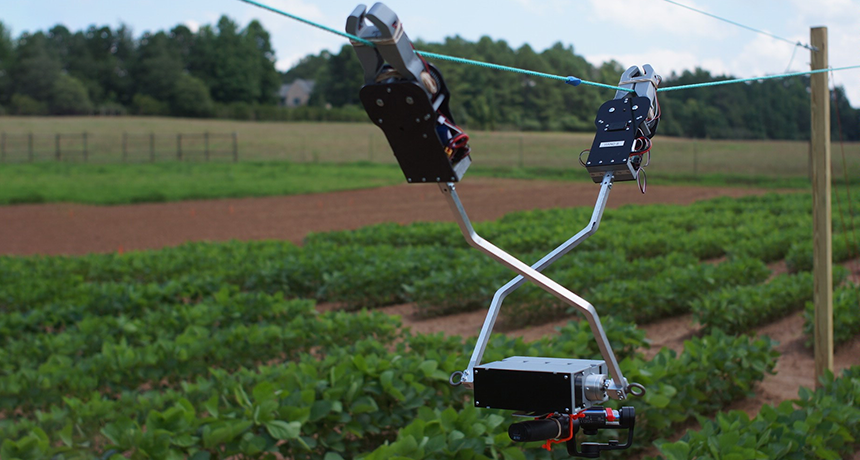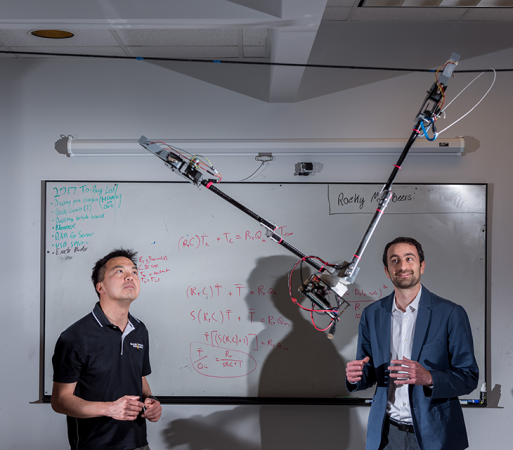Tarzan the robot was actually inspired by a sloth
This farm worker swings hand-over-hand to save energy — and avoid getting stuck in the mud

Tarzan, shown here, travels over crop fields with an energy-efficient swinging motion. One day, such robots might help with farm work.
Georgia Tech Research Institute
By Ilima Loomis
Working on a farm and tending crops can be hot, time consuming and difficult. Engineers have long wanted to build robots to lighten the load. But it has proven no easy task. Robots that walk or roll along the ground can trample delicate plants. And they can get bogged down when rain turns fields muddy. “Tarzan,” however, could overcome some of those challenges. Like its namesake, this new robot swings through the air.
Jonathan Rogers is a robotics expert at the Georgia Institute of Technology in Atlanta. When it comes to a farm environment, he realized, many robots would face a number of problems. “They tend to get tangled. They tend to get stuck,” he says. What’s more, he notes, “It’s very hard to leave them out for long periods without a human assisting them.”
That’s when inspiration hit him: What if the robot could move above the crops? After all, he realized, “Sloths move from tree branch to tree branch to avoid having to walk around the forest floor.”
Inspired, his team set out to design a robot that could swing hand-to-hand along wires suspended above a field. He named their invention Tarzan, after the jungle-swinging character of books and movie fame. Why not name it for a sloth? “There’s no famous sloths that I know of,” he says. (Apparently, Rogers never watched the 2016 Disney flick, Zootopia. If he had, he’d know about Flash, the “fastest working sloth in the DMV.”)
Drones, another type of robot, fly above the land. Yet these, too, have some disadvantages. A gust of wind can blow them off course, for instance. And if their propellers got too close, drones might damage plants. More importantly, drones have a short battery life. To tackle long tasks, farmers might have to recharge them every half hour or so.
Swinging, in contrast, is an energy-efficient motion. The reason: It makes use of gravity to power movement. This is similar to the way a child can pump her legs to get a playground swing to go higher and higher. With that efficiency, a robot like Tarzan can work out in a field for months at a time, without needing to be recharged, Rogers says.
What makes this swinger new
Tarzan is not the first swinging robot, notes Mark Spong. He’s a robotics researcher at the University of Texas at Dallas. Some teams have built robots that do gymnastics. Others imitate primates. He says one inventor even covered a swinging robot in fur to make it look like an orangutan. But what’s new, he says, is using swinging motion to save energy — and the idea of building a wire structure to move around above crops.
“When you’re out in the field and can’t plug into a wall socket, energy is really important,” he points out. “These [robots] can live out there and hang around and swing when they need to, maybe even recharge with solar cells.”
Rogers first envisioned that Tarzan could help farmers monitor crops with sensors and cameras. But future versions could do other work as well. They might deliver water to a particular thirsty plant or fertilize one that needs a nutritional boost. And adding a third “hand” could allow such an automaton to harvest fruits and vegetables.
Eventually the robot could move off the farm and into the city, Rogers says, doing jobs such as inspecting power lines or crawling around wires to move traffic sensors and security cameras from place to place.
While Tarzan has shown it has what it takes to swing around the lab, Rogers says the next step is to test the robot in the field. “We really want to get this robot crawling around networks of cables,” he says.

This is one in a series presenting news on technology and innovation, made possible with generous support from the Lemelson Foundation.







